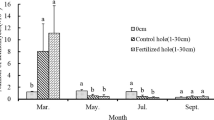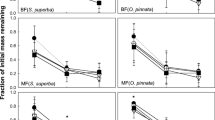Abstract
Litter production and litter decomposition influence the availability of nutrients in the soil. The investigation aimed at characterizing the dynamics of leaf litter decomposition, and soil physico-chemical and biological parameters in rubber plantations of different ages. During a 12-months’ period, field studies were done in 7-, 12-, and 25-year-old rubber plantations. For measuring of litter decomposition and input from aboveground, 324 litter bags and 27 litter traps (1 m × 1 m) were placed in 3 sampling areas per age class of rubber plantations. The soil parameters were also characterized. The results showed that the annual litter production and the amounts of organic carbon in leaves increased with the aging of the plantations. The annual decomposition constant (k) ranged from 0.0381 ± 0.0040 year−1 in the 25-year-old plantations to 0.0767 ± 0.0111 year−1 in the 7-year-old plantations. The annually decomposed litter mass varied between 2.7 ± 0.3 t ha−1 year−1 in the 12-year-old plantations to 4.2 ± 0.3 t ha−1 year−1 in the 25-year-old plantations. The soil of the 25-year-old plantations showed higher values of most physico-chemical and biological variables as compared to the 7-year-old plantations: annual litter production (+ 32%), annual litter mass decomposed (+ 11%), annual carbon (+ 15%) and nitrogen (+ 11%) inputs, soil organic carbon (+ 52%), total nitrogen (+ 32%), soil organic matter (+ 52%), soil water content (+ 74%), and the total density of soil invertebrates (+ 121%). The results indicate an improvement of soil properties with the aging of the rubber plantations and the importance of this agricultural system for carbon sequestration.



Similar content being viewed by others
References
Aerts R (2006) The freezer defrosting: global warming and litter decomposition rates in cold biomes. J Ecol 94:713–724
Allen K, Corre MD, Tjoa A, Veldkamp E (2015) Soil nitrogen-cycling responses to conversion of lowland forests to oil palm and rubber plantations in Sumatra, Indonesia. PLoS ONE. https://doi.org/10.1371/journal.pone.0133325
Anderson JM, Ingram JSI (1993) Tropical soil biology and fertility: a handbook of methods, 2nd edn. CABI, Wallingford
Assié KH, Angui P, Tamia AJ (2008) Effects of cultivation and natural constraints on some physical properties of a ferrallitic soil in Mid West of Côte d’Ivoire: consequences on soil degradation. Eur J Sci Res 23:149–166
Attignon SE, Weibel D, Lachat T, Sinsin B, Nagel P, Peveling R (2004) Leaf litter breakdown in natural and plantation forests of the Lama forest reserve in Benin. Appl Soil Ecol 27:109–124
Bardgett RD (2005) The biology of soil. A community and ecosystem approach. Oxford University Press, Oxford
Bedano JC, Ruf A (2007) Soil predatory mite communities (Acari: Gamasina) in agroecosystems of Central Argentina. Appl Soil Ecol 36:22–31
Berg B (2000) Litter decomposition and organic matter turnover in northern forest soils. For Ecol Manag 133:13–22
Bernhard-Reversat F, Loumeto JJ (2002) The litter system in African forest-tree plantations. In: Reddy MV (ed) Management of tropical plantation-forests and their soil litter system. Science Publishers Inc, Hauppauge, pp 11–39
Brando PM, Nepstad DC, Davidson EA, Trumbore SE, Ray D, Camargo P (2008) Drought effects on litterfall, wood production and belowground carbon cycling in an Amazon forest: results of a throughfall reduction experiment. Philos Trans R Soc B 363:1839–1848
Brindoumi JKA (2015) Les facteurs du développement de l’hévéaculture en Côte d’Ivoire de 1994 à 2012. Eur Sci J 11:202–219
Campbell BM, Beare DJ, Bennett EM, Hall-Spencer JM, Ingram JSI, Jaramillo F, Ortiz R, Ramankutty N, Sayer JA, Shindell D (2017) Agriculture production as a major driver of the earth system exceeding planetary boundaries. Ecol Soc. https://doi.org/10.5751/ES-09595-220408
Chaudhuri PS, Nath S (2011) Community structure of earthworms under rubber plantations and mixed forests in Tripura, India. J Environ Biol 32:537–541
Chaudhuri PS, Bhattacharjee S, Dey A, Chattopadhyay S, Bhattacharya D (2013) Impact of age of rubber (Hevea brasiliensis) plantation on earthworm communities of West Tripura (India). J Environ Biol 34:59–65
Chiti T, Grieco E, Perugini L, Rey A, Valentini R (2014) Effect of the replacement of tropical forests with tree plantations on soil organic carbon levels in the Jomoro district, Ghana. Plant Soil 375:47–59
CNRA (2013) Le Centre National de Recherche Agronomique en 2012. Nous inventons aujourd’hui l’agriculture de demain. http://www.cnra.ci/publi.php. Accessed 25 Jan 2015
Coleman DC, Crossley DA Jr, Hendrix PF (2004) Fundamentals of soil ecology, 2nd edn. Academic Press, Burlington
Dash MC, Behera N (2013) Carbon sequestration and role of earthworms in Indian land uses: a review. Ecoscan 7:1–7
Ettian MK, Soulemane O, Tahou TM (2009) Influence du régime alimentaire sur l’intervalle de parturition des aulacodes en captivité dans la région de Grand-Lahou (Côte d’Ivoire, Afrique de l’Ouest). J Anim Plant Sci 4:311–319
Gallardo JF, Saavedra J, Martin-Patino T, Millan A (1987) Soil organic matter determination. J Com Soil Sci Plant Anal 18:699–707
Gilot C, Lavelle P, Blancart E, Keli J, Kouassi P, Guillaume G (1995) Biological activity of soil under plantations in Côte d’Ivoire. Acta Zool Fennica 196:186–189
Gréggio TC, Assis LC, Nahas E (2008) Decomposition of the rubber tree Hevea brasiliensis litter at two depths. Chilean J Agric Res 68:128–135
Hamilton RL, Trimmer M, Bradley C, Pinay G (2016) Deforestation for oil palm alters the fundamental balance of the soil N cycle. Soil Biol Biochem 95:223–232
Keenan RJ, Reams GA, Achard F, De Freitas JV, Grainger A, Lindquist E (2015) Dynamics of global forest area: results from the FAO Global Forest Resources Assessment 2015. For Ecol Manag 352:9–20
Konan KS, Kouassi KL, Kouamé KI, Kouassi AM, Gnakri D (2013) Hydrologie et hydrochimie des eaux dans la zone de construction du chenal du port de pêche de Grand-Lahou, Côte d’Ivoire. Int J Biol Chem Sci 7:819–831
Kongsager R, Napier J, Mertz O (2013) The carbon sequestration potential of tree crop plantations. Mitig Adapt Strateg Glob Change 18:1197–1213
Kotowska MM, Leuschner C, Triadiati T, Hertel D (2016) Conversion of tropical lowland forest reduces nutrient return through litterfall, and alters nutrient use efficiency and seasonality of net primary production. Oecologia 180:601–618
Krashevska V, Klarner B, Widyastuti R, Maraun M, Scheu S (2015) Impact of tropical lowland rainforest conversion into rubber and oil palm plantations on soil microbial communities. Biol Fertil Soils. https://doi.org/10.1007/s00374-015-1021-4
Krashevska V, Klarner B, Widyastuti R, Maraun M, Scheu S (2016) Changes in structure and functioning of protist (testate amoebae) communities due to conversion of lowland rainforest into rubber and oil palm plantations. PLoS ONE. https://doi.org/10.1371/journal.pone.0160179
Kurzatkowski D, Martius C, Höfer H, Garcia M, Förster B, Beck L, Vlek P (2004) Litter decomposition, microbial biomass and activity of soil organisms in three agroforestry sites in central Amazonia. Nutr Cycl Agroecosyst 69:257–267
Lavelle P, Bignell D, Lepage M, Wolters V, Roger P, Ineson P, Heal OW, Dhillion S (1997) Soil function in a changing world: the role of invertebrate ecosystem engineers. Eur J Soil Biol 33:159–193
Li Y, Lan G, Xia Y (2016) Rubber trees demonstrate a clear retranslocation under seasonal drought and cold stresses. Front Plant Sci. https://doi.org/10.3389/fpls.2016.01907
Liu H, Blagodatsky S, Giese M, Liuc F, Xu J, Cadisch G (2016) Impact of herbicide application on soil erosion and induced carbon loss in a rubber plantation of Southwest China. CATENA 145:180–192
Mande HK, Abdullah AM, Aris AZ, Nuruddin AA (2014) A comparison of soil CO2 efflux rate in young rubber plantation, oil palm plantation, recovering and primary forest ecosystems of Malaysia. Pol J Environ Stud 23:1649–1657
Martius C, Höfer H, Garcia MVB, Römbke J, Hanagarth W (2004) Litter fall, litter stocks and decomposition rates in rainforest and agroforestry sites in central Amazonia. Nutr Cycl Agroecosyst 68:137–154
Nelson DW, Sommers LE (1982) Total carbon, organic carbon, and organic matter. In: Page AL, Miller RH, Keeney DR (eds) Methods of soil analysis. Part II, 2nd edn. American Society of Agronomy, Madison, pp 539–580
Podong C, Poolsiri R (2012) Effects of land use types on carbon and nitrogen content in litter in huai lam kradonsubwatershed, lower northern Thailand. In: International conference on eco-systems and biological sciences penang (Malaysia) May 19–20, pp 44–50
Podong C, Poolsiri R, Katzensteiner K, Pengthamkeerati P, Thongdeenok P (2013) Species diversity and litter dynamics in secondary mixed deciduous forest, thung salaeng lung national park, northern, Thailand. Folia For Pol 55:196–204
Ruf F (2009) L’adoption de l’hévéaculture en Côte d’Ivoire Prix, imitation et changement écologique. Session: Innovation des agricultures familiales et politiques publiques. Le cas de l’hévéaculture. 3èmes journées de recherches en sciences sociales. INRA-SFER-CIRAD, Montpellier, France. www.sfer.asso.fr/content/download/3013/27367/version/1/file/E1+-+RUF.pd. Accessed 15 Feb 2015
Tié Bi T, Ornont H (1987) Etude des sols de parcelles d’hévéa en basse Côte d’Ivoire. In: Reddy MV (ed) Management of tropical plantation-forests and their soil litter system. Science Publishers Inc, Hauppauge, pp 16–26
Tondoh EJ, Kouamé FN, Guéi AM, Sey B, Koné AW, Gnessougou N (2015) Ecological changes induced by full-sun cocoa farming in Côte d’Ivoire. Glob Ecol Conserv 3:575–595
Torreta NK, Takeda H (1999) Carbon and nitrogen dynamics of decomposing leaf litter in a tropical hill evergreen forest. Eur J Soil Biol 35:57–63
Ukonmaanaho L, Merilä P, Nöjd P, Nieminen TM (2008) Litterfall production and nutrient return to the forest floor in Scots pine and Norway spruce stands in Finland. Boreal Environ Res 13:67–91
Walkley A, Black IA (1934) An examination of the Degtjareff method for determining soil organic matter and a proposed modification of the chromic titration method. Soil Sci 34:29–38
Waneukem V, Ganry F (1992) Relations entre les formes d’azote organique du sol et l’azote absorbé par la plante dans un sol ferrallitique du Sénégal. Cirad-CA, UR facteurs et conditions du milieu. Cahiers ORSTOM ser Pédologie 27:97–107
Yang X, Chen J (2009) Plant litter quality influences the contribution of soil fauna to litter decomposition in humid tropical forests, southwestern China. Soil Biol Biochem 41:910–918
Acknowledgments
The authors gratefully acknowledge the financial support of International Foundation for Science (IFS) through the Project Ref. D/5287-1 and titled “Effect of age of rubber plantations on the soil microarthropods diversity and the recycling of the organic matter in the Grand Lahou department”, which made this study possible. Thank to farmers, SODEFOR and IDH staff for their involvement in identifying suitable plantations for this work. A big thank you goes out to Prof Jérôme E. Tondoh for his assistance during the field works and data analysis. Thanks to Dr. Martine Kah Touao GAUZE, Director of the Ecological Research Center for hosting the project in her center.
Author information
Authors and Affiliations
Corresponding author
Ethics declarations
Conflict of interest
The authors declare that they have no conflict of interest.
Ethical approval
This article does not contain any studies with human participants or animals performed by any of the authors.
Informed consent
Informed consent was obtained from all individual participants included in the study.
Rights and permissions
About this article
Cite this article
N’Dri, J.K., Guéi, A.M., Edoukou, E.F. et al. Can litter production and litter decomposition improve soil properties in the rubber plantations of different ages in Côte d’Ivoire?. Nutr Cycl Agroecosyst 111, 203–215 (2018). https://doi.org/10.1007/s10705-018-9923-9
Received:
Accepted:
Published:
Issue Date:
DOI: https://doi.org/10.1007/s10705-018-9923-9




